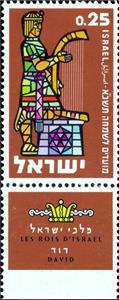Stamp with Collectible Margin: King David (Israel 1960)
King David (Israel 1960)
31 August (Israel ) within release Festival 1960 goes into circulation Stamp with Collectible Margin King David face value 0.25 Israeli lira
| Stamp with Collectible Margin King David in catalogues | |
|---|---|
| Michel: | Mi: IL 218T |
| Stamp Number: | Sn: IL 185T |
| Yvert et Tellier: | Yt: IL 180T |
| Stanley Gibbons: | Sg: IL 192T |
Stamp with Collectible Margin is square format.
Also in the issue Festival 1960:
- Stamp - Symbolic drawings of the first Kings of Israel: Saul face value 0.07;
- Stamp - Symbolic drawings of the first Kings of Israel: David face value 0.25;
- Stamp - Symbolic drawings of the first Kings of Israel: Solomon face value 0.40;
- First Day Cover - Festival 1960 face value 0.72;
- Stamp with Collectible Margin - King David face value 0.25;
- Stamp with Collectible Margin - King Saul face value 0.07;
- Stamp with Collectible Margin - King Solomon face value 0.40;
- Full Pane - King David face value 20*0.25;
- Full Pane - King Saul face value 20*0.07;
- Full Pane - King Solomon face value 20*0.40;
Stamp with Collectible Margin King David it reflects the thematic directions:
Drawing is a visual art that uses an instrument to mark paper or another two-dimensional surface. The instrument might be pencils, crayons, pens with inks, brushes with paints, or combinations of these, and in more modern times, computer styluses with graphics tablets.
A festival is an event celebrated by a community and centering on some characteristic aspect or aspects of that community and its religion or cultures. It is often marked as a local or national holiday, mela, or eid. A festival constitutes typical cases of glocalization, as well as the high culture-low culture interrelationship. Next to religion and folklore, a significant origin is agricultural. Food is such a vital resource that many festivals are associated with harvest time. Religious commemoration and thanksgiving for good harvests are blended in events that take place in autumn, such as Halloween in the northern hemisphere and Easter in the southern.
King is the title given to a male monarch in a variety of contexts. The female equivalent is queen regnant (while the title of queen on its own usually refers to the consort of a king). In the context of prehistory, antiquity and contemporary indigenous peoples, the title may refer to tribal kingship. Germanic kingship is cognate with Indo-European traditions of tribal rulership (c.f. Indic rājan, Gothic reiks, and Old Irish rí, etc.) In the context of classical antiquity, king may translate Latin rex or either Greek archon or basileus. In classical European feudalism, the title of king as the ruler of a kingdom is understood as the highest rank in the feudal order, potentially subject, at least nominally, only to an emperor (harking back to the client kings of the Roman Empire). In a modern context, the title may refer to the ruler of one of a number of modern monarchies (either absolute or constitutional). The title of king is used alongside other titles for monarchs, in the West prince, emperor, archduke, duke or grand duke, in the Middle East sultan or emir; etc. Kings, like other royalty, tend to wear purple because purple was an expensive color to wear in the past.
The New Year is the time or day at which a new calendar year begins and the calendar's year count increments by one. Many cultures celebrate the event in some manner. In the Gregorian calendar, the most widely used calendar system today, New Year occurs on January 1 (New Year's Day, preceded by New Year's Eve). This was also the first day of the year in the original Julian calendar and the Roman calendar (after 153 BC)




